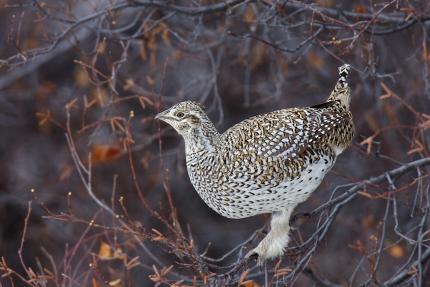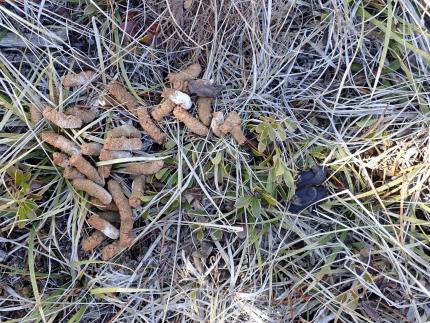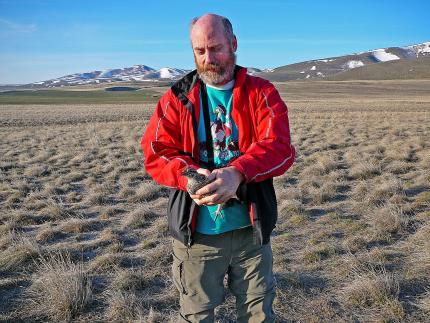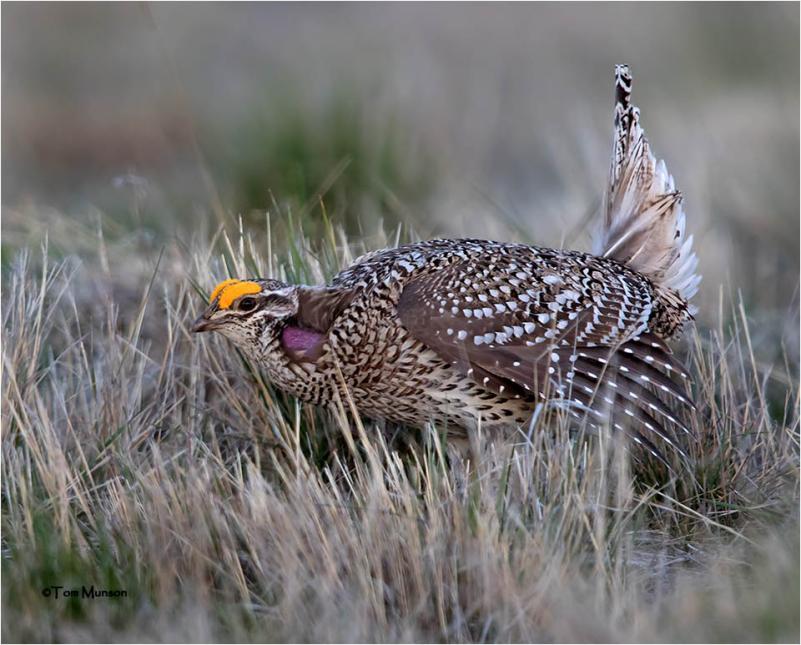Moderate
The population size of Columbian sharp-tailed grouse in Washington is low. The statewide population of this grouse species is distributed in seven subpopulations that are not sustainable. Shortages of nesting, brood rearing, and wintering habitats are important factors limiting population recovery. Maintaining the species in Washington will require restoring habitat and increasing populations.
Description and Range
Physical description
This species is considered a medium-sized grouse. The total length is 17 inches. Males are heavier than females. In both sexes, the body is round, with short legs, short crest, and elongated central rectrices (tail feathers). Head, neck, back, and wings are heavily barred with dark brown, blackish, and buff coloring, while breast feathers are white, with tawny drab margins. The upper belly feathers are white. When this species is observed on the ground, it exhibits a "frosty" appearance. Nostrils and legs are feathered. Both sexes have a crescent-shaped, yellowish-orange comb over the eye. The male is identified by pinkish to pale violet air sacs on each side of the neck (exposed and inflated only during courtship displays).
Ecology and life history
Sharp-tailed grouse are a grassland and shrubsteppe species, and the Palouse prairie probably once supported the highest numbers in Washington. Diverse native grassland with sparse shrubs provides the best nesting habitat, but deciduous riparian habitat must be available in the area for overwintering. Sharp-tailed grouse will also use cropland near native habitat, such as wheat stubble and alfalfa, and this species benefits from the U.S. Department of Agriculture Conservation Reserve Program.

Good sharp-tailed grouse habitat contains a mix of perennial bunchgrasses, forbs, and a few shrubs. In Washington, riparian areas with deciduous trees and shrubs that provide cover, berries, seeds, buds, and catkins provide critical winter habitat when the ground is snow-covered. The most important trees and shrubs include water birch, serviceberry, chokecherry, rose, hawthorn, snowberry, cottonwood, and aspen.
During spring and summer, this species eats a variety of “forbs” (non-woody flowering plants), grasses, and insects. During late fall and winter, particularly after snow covers the ground, sharp-tailed grouse will move to areas with riparian deciduous cover where they often eat buds and fruits of deciduous trees and shrubs, such as water birch, serviceberry, hawthorn, and aspen.

Males gather at lek sites in spring -- a lek is an assembly of male grouse engaged in courtship displays. At these sites, males perform elaborate dances to attract females for mating. Females nest under a grass clump or shrub and incubate a clutch of approximately 10 to 14 eggs.
The chicks feed on insects, gradually shifting to more plant material. Young chicks are particularly vulnerable to predators. Maturing broods aggregate into flocks in late summer. Annual adult survival of non-hunted populations ranges from 30 to 60 percent, and the maximum lifespan reported is seven and a half years.
Geographic range
This grouse is the rarest race of sharp-tailed grouse. Seven remnant populations of Columbian sharp-tailed grouse remain in Douglas, Lincoln, and Okanogan counties. Washington populations may have once numbered in the hundreds of thousands. The total population now numbers fewer than 1,000 birds, and they occupy less than 5 percent of their historical range.
For maps of range-wide distribution and conservation status of this species, check out the International Union for Conservation of Nature - Red List and NatureServe Explorer.
Climate vulnerability
Sensitivity to climate change
Moderate
Sharp-tailed grouse chicks experience high mortality rates during prolonged wet spring weather. Overall sensitivity of this species is likely driven by habitat specialization (e.g., grassland or shrub-steppe). Habitat suitability for this species could decrease or shift in response to altered fire regimes, invasive species spread (i.e., cheatgrass), and changes in precipitation and hydrology that affect riparian winter habitat.
Exposure to climate change
Moderate
- Increases in spring precipitation
- Altered fire regimes
- Changes in precipitation overall
- Increased invasive weeds
Conservation
Conservation Threats and Actions Needed

- Agriculture and aquaculture side effects
- Threat: Habitat converted to cropland (loss and fragmentation); lack of connectivity.
- Action Needed: Protect and restore key habitats using a variety of conservation tools; translocations may be needed in some cases.
- Threat: Habitat converted to cropland.
- Action Needed: U.S. Department of Agriculture Conservation Reserve Program - State Acres For Wildlife Enhancement (CRP-SAFE) contracts.
- Fish and wildlife habitat loss or degradation
- Threat: Small populations, potential declining genetic health.
- Action Needed: Population augmentation.
See the Climate Vulnerability section for information about the threats posed by climate change to this species.
Resources
WDFW publications
PHS Program
Status reports
- Periodic Status Review for the Columbian Sharp-tailed Grouse in Washington (2025)
- Periodic Status Review for the Columbian Sharp-tailed Grouse in Washington (2017)
- Washington State Status Report for the Sharp-tailed Grouse (1998)
Recovery plans
- Washington State Recovery Plan for the Columbian Sharp-tailed Grouse (2012)
- Recovery of Sharp-tailed Grouse in Washington: 2023 Progress Report (PDF)
- Recovery of Sharp-tailed Grouse in Washington: 2019 Progress Report
- Recovery of Columbian Sharp-tailed Grouse in Washington: 2016 Progress Report
- Recovery actions
- Re-establishment of Viable Populations of Columbian Sharp-tailed Grouse in Washington: 2015 Progress Report
- Re-establishment of Viable Populations of Columbian Sharp-tailed Grouse in Washington: 2013 Progress Report
- Re-establishment of Viable Populations of Columbian Sharp-tailed Grouse in Washington: 2012 Progress Report
- Re-establishment of Viable Populations of Columbian Sharp-tailed Grouse in Washington: 2011 Progress Report
- Re-establishment of Viable Populations of Columbian Sharp-tailed Grouse in Washington: 2010 Progress Report
- Re-establishment of Viable Populations of Columbian Sharp-tailed Grouse in Washington: 2009 Progress Report
- Re-establishment of Viable Populations of Columbian Sharp-tailed Grouse in Washington: 2008 Progress Report


